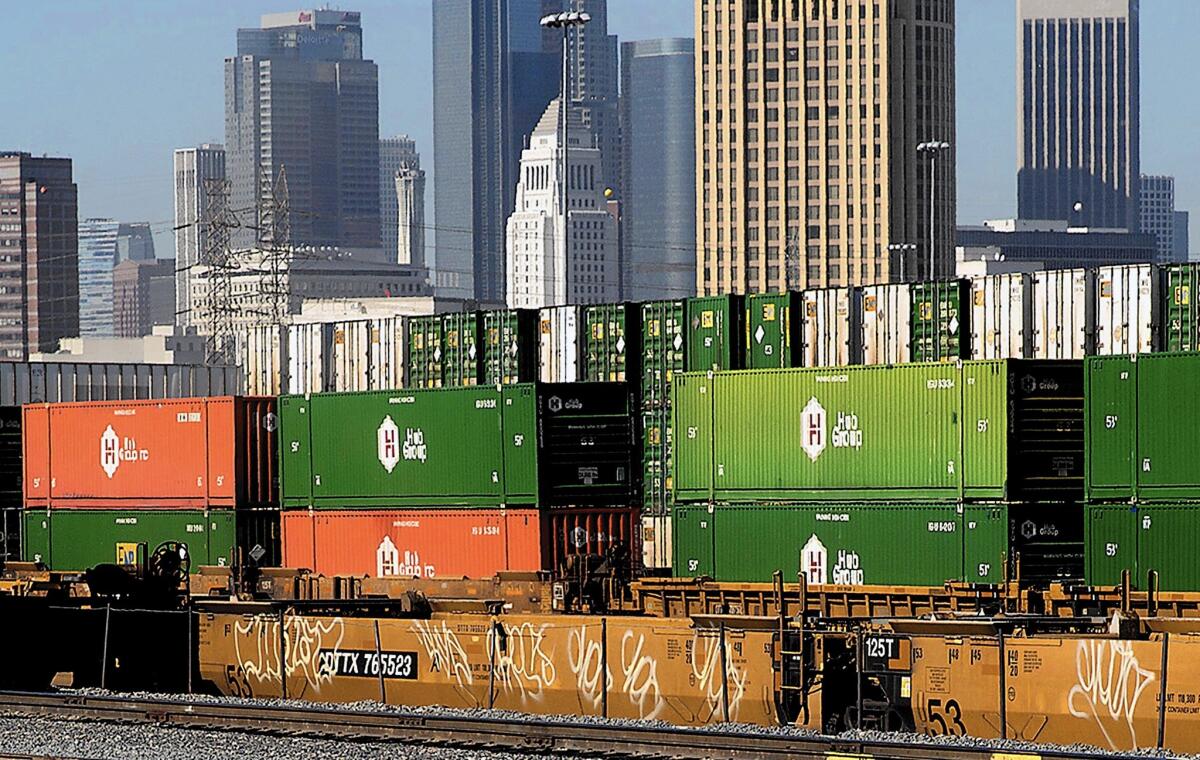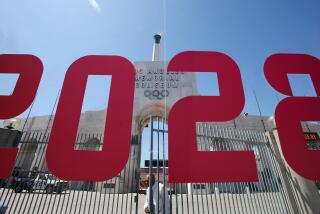First & Spring: L.A.’s Olympic ambitions could boost river restoration – but at what cost?

The Piggyback Yard, a 120-acre parcel owned by Union Pacific Corp., is a crucial part of L.A.’s river restoration project. The yard also has been identified by L.A.’s Olympic Committee as a potential site for a new village to house 16,500 athletes.
For years, politicians, activists and community groups have been laying the groundwork for a transformation of the Los Angeles River, one that would rip up stretches of concrete and add parks, wetlands and other natural spaces.
To those advocates, few pieces of riverfront property are more crucial than the one nicknamed Piggyback Yard, on the edge of downtown. Redevelopment of the site, which houses an active rail yard, is expected to consume nearly half the river project’s estimated $1.35-billion budget. At roughly 120 acres, it’s the largest parcel of riverfront land targeted for restoration.
City officials had been looking at a completion date for the rail yard project of 2033, depending on federal funding and other factors. But those assumptions were upended this summer, after Los Angeles re-entered the running for the 2024 Olympics.
In the initial bidding materials, L.A.’s Olympic committee identified the rail yard as the site of a new residential village that would house 16,500 athletes. Now, backers of the river say the Olympic Village concept could achieve another goal: building the most complicated piece of the 11.5-mile restoration, years ahead of schedule.
“This could be an opportunity to speed it up and actually make it a reality,” said Deputy Mayor Barbara Romero, who handles river issues for Mayor Eric Garcetti.
Garcetti has made the proposed river restoration, which would be managed by the Army Corps of Engineers, a central part of his agenda. River advocates, in turn, are anxious to make sure their goals for the site — adding wetlands, a flood detention area and other improvements — are factored into any Olympic planning efforts.
Yet for those interests to converge, a string of extraordinary events would need to fall into place. In the contest for the 2024 summer games, L.A. would need to prevail over Paris, Rome and other cities. Property owner Union Pacific Corp. would have to agree to sell Piggyback Yard, known formally as the Los Angeles Trailer and Container Intermodal Facility.
Any contaminated soil on the site would need to be cleaned up. And Union Pacific would need a “suitable replacement facility” elsewhere for its rail yard operation, which moves 240,000 containers a year.
“Union Pacific has no plans to relocate or close this facility and is in fact planning a major modernization,” wrote John Koraleski, Union Pacific’s chairman and chief executive, in a 2014 letter to Garcetti and Olympic organizers.
With so many variables in play, budget analysts at City Hall have warned the cost of an Olympic Village on the rail yard could “significantly exceed” the $1 billion listed for the project in the initial bidding materials.
Relocating Union Pacific, then building thousands of housing units on a contaminated rail yard, could easily become a “budget buster” for both the city and taxpayers, warned Zev Yaroslavsky, a former county supervisor who is now director of the L.A. Initiative at UCLA’s Luskin School of Public Affairs and Department of History.
Yaroslavsky says he has been urging L.A.’s Olympic organizers to shift their focus away from the rail yard and toward housing sites at USC and UCLA. “The cost of providing the village in those two venues is far less risky and far less expensive than building a brand-new village on property that is laden with toxic deposits,” he said.
LA24, the committee designing the Olympic bid, now describes Piggyback Yard as just one of several locations being examined for an athlete village. Still, committee spokesman Jeff Millman said development on the gritty industrial site, which sits across the river from the Twin Towers jail, would offer clear benefits for the public.
Converting Piggyback Yard into an Olympic Village “would support the continued revitalization and neighborhood renewal along the L.A. River, providing a significant legacy from the games,” Millman said in an email.
Environmentalists, urban planners and others have long sought a redesign of the Los Angeles River, which was lined with a concrete channel in the middle of the 20th century, after a pair of devastating floods. The restoration plan favored by Garcetti, which would be carried out by the U.S. Army Corps of Engineers, focuses on a stretch of river running from Griffith Park to downtown.
Backers of that project contend it’s not unrealistic to think that Piggyback Yard could be redeveloped in time for the 2024 games.
High-density housing, built on the edges of the site, would initially be occupied by the athletes, said Mia Lehrer, who runs an L.A. landscape architecture firm that has studied the rail yard extensively. Once the games are over, she said, those buildings could become part of a “new amazing riverside district that overlooks downtown.”
“These kinds of complex projects happen in cities, and it doesn’t always have to come from city coffers,” Lehrer added. “It comes from ingenious financing strategies. I think developers are out there who are probably interested and it’s just a matter of figuring it out.”
Piggyback Yard has long been a topic of interest for backers of a river restoration. But it was not until recent years that advocates started working on more formal designs for remaking the rail facility, said Lewis MacAdams, president of the nonprofit Friends of the Los Angeles River.
Lehrer’s firm put together designs for replacing the rail yard, working alongside architects, land-use consultants, nonprofit groups and at least one hydrologist. The group looked at options for developing as much as 40% of the site. It also called for one side of the channel to be reopened so that water could collect and then percolate into the groundwater table.
“Basically, if you’re going to take out concrete, you’re going to have to widen the river,” MacAdams said. “And Piggyback Yard is the ultimate place to widen the river.”
The study group called for athletic fields to be placed at a higher elevation, away from the river. And it proposed housing, office space and other commercial uses at the site’s highest points.
Omar Brownson, who heads the nonprofit L.A. River Revitalization Corp., said he expects that if the rail yard becomes a formal part of the Olympic effort, a much more extensive public discussion of the site will begin.
“Obviously, the L.A. River is a great public resource,” he said. “The Olympics is a great public sporting event. Asking how do we bring these things together is a good problem to have.”
Twitter: @davidzahniser
More to Read
Start your day right
Sign up for Essential California for news, features and recommendations from the L.A. Times and beyond in your inbox six days a week.
You may occasionally receive promotional content from the Los Angeles Times.






